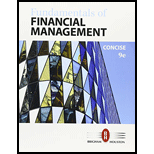
Fundamentals of Financial Management, Concise Edition
9th Edition
ISBN: 9781337087544
Author: Eugene F. Brigham, Joel F. Houston
Publisher: Cengage Learning
expand_more
expand_more
format_list_bulleted
Question
Chapter 1, Problem 11Q
Summary Introduction
To determine: The effect of the investment on the company’s earnings per share, intrinsic value and the price of the stock.
Introduction:
Intrinsic Value: The true value of the share which is based on the future earnings of the company determined by considering present worth and future earning that is intended for the shareholder.
Earnings per Share: Earnings per share are the monetary values of the share which dhows the profitability of the company and it is considered as that part of the profit which is distributed to number of shares outstanding
Expert Solution & Answer
Want to see the full answer?
Check out a sample textbook solution
Students have asked these similar questions
A person wants to accumulate $10,000 in 4 years. How much should they invest annually if the interest rate is 6% compounded annually?
A) $2,500B) $2,352.34C) $2,275.49D) $2,100
What is the present value of $2,000 to be received after 3 years, discounted at 10% per annum?
A) $1,500.25B) $1,502.63C) $1,450D) $1,800 step by step
No Ai ..???
10. A company offers a 10% discount on all purchases over $100. If you buy something for $120, how much will you pay after the discount?
Chapter 1 Solutions
Fundamentals of Financial Management, Concise Edition
Ch. 1 - What is a firms intrinsic value? Its current stock...Ch. 1 - When is a stock said to be in equilibrium? Why...Ch. 1 - Prob. 3QCh. 1 - Prob. 4QCh. 1 - Prob. 5QCh. 1 - Prob. 6QCh. 1 - Should stockholder wealth maximization be thought...Ch. 1 - Prob. 8QCh. 1 - The president of Southern Semiconductor...Ch. 1 - Prob. 10Q
Knowledge Booster
Similar questions
- What is the present value of $2,000 to be received after 3 years, discounted at 10% per annum? A) $1,500.25B) $1,502.63C) $1,450D) $1,800explain.arrow_forwardNo ai..,, ?? No gpt you invest $5,000 in a mutual fund that charges a 1.5% management fee and a 0.5% administrative fee. If the fund returns 8% over a year, what is your net return?arrow_forwardNo ai..???You invest $2,000 in a certificate of deposit (CD) with a 4% annual interest rate for 2 years. How much interest will you earn?arrow_forward
- A project requires an initial investment of $100,000 and generates annual cash flows of $20,000 for 5 years. If the discount rate is 10%, what is the project's net present value (NPV)? no ai help ..???arrow_forwarddear expert!!Please don't solve with incorrect values . i will give unhelpful.arrow_forwardWhat is the present value of $2,000 to be received after 3 years, discounted at 10% per annum? A) $1,500.25B) $1,502.63C) $1,450D) $1,800arrow_forward
- If a business buys supplies on credit, which of the following accounts will be affected?a) Supplies and Accounts Payableb) Cash and Suppliesc) Accounts Receivable and Suppliesd) Supplies and Casharrow_forwardPlease don't solve with incorrect values . i will give unhelpful.arrow_forwardA project requires an initial investment of $100,000 and generates annual cash flows of $20,000 for 5 years. If the discount rate is 10%, what is the project's net present value (NPV)? help..??arrow_forward
- You are given the following information concerning four stocks: Using 20X0 as the base year, construct three aggregate measures of the market that simulate the Dow Jones Industrial Average, the S&P 500 stock index, and the Value Line stock index (i.e., a simple average, a value-weighted average, and a geometric average). a. What is the percentage change in each aggregate market measure from 20X0 to 20X1, and 20X0 to 20X2? Why are the results different even though only one stock’s price changed and in each case the price that changed doubled? b. If you were managing funds and wanted a source to compare your results, which market measure would you prefer to use in 20X2? *Show all work & necessary formula(s)arrow_forward7. If the inflation rate is 3% and the nominal return on an investment is 8%, what is the real return approximately? A) 5.0%B) 4.9%C) 5.2%D) 6.0%arrow_forward7. If the inflation rate is 3% and the nominal return on an investment is 8%, what is the real return approximately? A) 5.0%B) 4.9%C) 5.2%D) 6.0%need help properly.arrow_forward
arrow_back_ios
SEE MORE QUESTIONS
arrow_forward_ios
Recommended textbooks for you
 Intermediate Financial Management (MindTap Course...FinanceISBN:9781337395083Author:Eugene F. Brigham, Phillip R. DavesPublisher:Cengage Learning
Intermediate Financial Management (MindTap Course...FinanceISBN:9781337395083Author:Eugene F. Brigham, Phillip R. DavesPublisher:Cengage Learning EBK CONTEMPORARY FINANCIAL MANAGEMENTFinanceISBN:9781337514835Author:MOYERPublisher:CENGAGE LEARNING - CONSIGNMENT
EBK CONTEMPORARY FINANCIAL MANAGEMENTFinanceISBN:9781337514835Author:MOYERPublisher:CENGAGE LEARNING - CONSIGNMENT Financial Reporting, Financial Statement Analysis...FinanceISBN:9781285190907Author:James M. Wahlen, Stephen P. Baginski, Mark BradshawPublisher:Cengage Learning
Financial Reporting, Financial Statement Analysis...FinanceISBN:9781285190907Author:James M. Wahlen, Stephen P. Baginski, Mark BradshawPublisher:Cengage Learning

Intermediate Financial Management (MindTap Course...
Finance
ISBN:9781337395083
Author:Eugene F. Brigham, Phillip R. Daves
Publisher:Cengage Learning


EBK CONTEMPORARY FINANCIAL MANAGEMENT
Finance
ISBN:9781337514835
Author:MOYER
Publisher:CENGAGE LEARNING - CONSIGNMENT

Financial Reporting, Financial Statement Analysis...
Finance
ISBN:9781285190907
Author:James M. Wahlen, Stephen P. Baginski, Mark Bradshaw
Publisher:Cengage Learning
